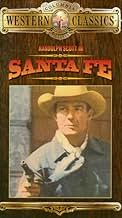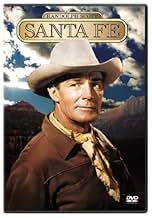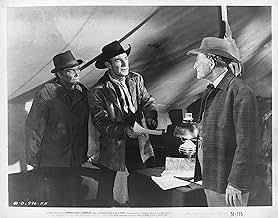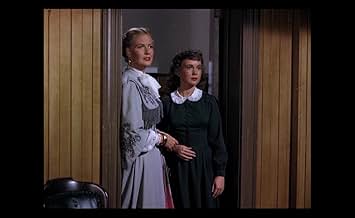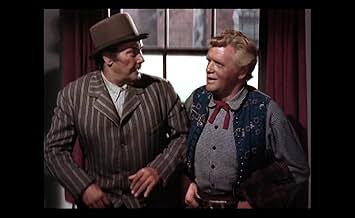VALUTAZIONE IMDb
6,1/10
1224
LA TUA VALUTAZIONE
Aggiungi una trama nella tua linguaAfter their service in the Civil War, four brothers go their separate ways, but later find themselves on opposite sides of a final showdown.After their service in the Civil War, four brothers go their separate ways, but later find themselves on opposite sides of a final showdown.After their service in the Civil War, four brothers go their separate ways, but later find themselves on opposite sides of a final showdown.
- Regia
- Sceneggiatura
- Star
Peter M. Thompson
- Tom Canfield
- (as Peter Thompson)
Olin Howland
- Dan Dugan
- (as Olin Howlin)
Jock Mahoney
- Crake
- (as Jock O'Mahoney)
Recensioni in evidenza
The time period for this film is actually pretty common for a Randolph Scott western--and about the fourth or fifth one set just after the Civil War. Like most of the films, Randolph fought for the South and now that the war is over, he has a choice to either accept the outcome or be a whiny jerk about it. Well, he's a smart guy and soon gets a job working for the Santa Fe railroad, but his three brothers who served with him aren't so bright--they hate the North so much that they do what they can to wreck things--even though there is no reasonable reason for this. So, much of the film pits Scott against his own kin (and vice-versa) as he tries hard to get the railroad completed and they work to undo it as much as possible--working for a traveling saloon whose task, it seems, is to both make money off the workers AND get them distracted from their job.
In addition to his brothers, Scott deals with a wide variety of things that might impede the progress of the railroad--rival companies, local Indian tribes and the like. This makes Scott's job in the film as a sort of trouble-shooter. How true all these problems were in the construction of the rails is beyond me and I assume that the writers took a few liberties...just a few! Overall, the film is pretty good. While it isn't among Scott's best films (they were made later in the decade and the early 60s), this is a good film from this time period.
In addition to his brothers, Scott deals with a wide variety of things that might impede the progress of the railroad--rival companies, local Indian tribes and the like. This makes Scott's job in the film as a sort of trouble-shooter. How true all these problems were in the construction of the rails is beyond me and I assume that the writers took a few liberties...just a few! Overall, the film is pretty good. While it isn't among Scott's best films (they were made later in the decade and the early 60s), this is a good film from this time period.
A former Confederate soldier takes a job building the Santa Fe railroad after the end of the Civil War and tries to persuade his three brothers to join him, fearing they will otherwise fall into a life of crime owing to their enduring hatred of the North
It's another solid Randolph Scott western, which covers the railroad expansion of SantaFe. The railroad and its set pieces convey the hard work that was done quite well. The conflict is on par too, which has Indians, gambling tents and rival companies disrupting Scott's efforts to build a railroad - but his brothers, who have gone on the outlaw track, make things awkward for Scott, and as a head of the family he takes upon himself to stop them. Which leads to gunfights, and particular exciting train fight between Scott and Jock Mahoney. It's a typically enjoyable western that also conveys the treatment of southerners from carpetbaggers and such like after the civil war.
It's another solid Randolph Scott western, which covers the railroad expansion of SantaFe. The railroad and its set pieces convey the hard work that was done quite well. The conflict is on par too, which has Indians, gambling tents and rival companies disrupting Scott's efforts to build a railroad - but his brothers, who have gone on the outlaw track, make things awkward for Scott, and as a head of the family he takes upon himself to stop them. Which leads to gunfights, and particular exciting train fight between Scott and Jock Mahoney. It's a typically enjoyable western that also conveys the treatment of southerners from carpetbaggers and such like after the civil war.
Santa Fe is directed by Irving Pichel and adapted to screenplay by Kenneth Gamet from the James Marshall novel and a story by Louis Stevens. It stars Randolph Scott, Janis Carter, Peter M. Thompson, Jerome Courtland and John Archer. A Technicolor production, it's photographed by Charles Lawton Jr. Story is set following the American Civil war and finds Scott as Britt Canfield, one of four ex-Confederate brothers heading West for a new life. While Britt finds honest employment on the Santa Fe railroad, his brothers veer towards the other side of the law.
A routine Western boosted by some quality set pieces and a well crafted script. Watchable from the off, film follows a true course whilst launching off narratively from the bitterness still felt by those who were on opposite sides of the war. It pitches Scott front and centre as the stoic character fending off all sorts of challenges, challenges that come courtesy of Indians, rival companies and his own kin! The acting around Scott is pretty average, tho the comic relief from Billy House & Olin Howland is most appealing, while it would have been nice to have some more imposing scenery filling out the screen. All told it's a safe recommendation to Western fans, even if ultimately it's not a genre film to revisit often. 6/10
A routine Western boosted by some quality set pieces and a well crafted script. Watchable from the off, film follows a true course whilst launching off narratively from the bitterness still felt by those who were on opposite sides of the war. It pitches Scott front and centre as the stoic character fending off all sorts of challenges, challenges that come courtesy of Indians, rival companies and his own kin! The acting around Scott is pretty average, tho the comic relief from Billy House & Olin Howland is most appealing, while it would have been nice to have some more imposing scenery filling out the screen. All told it's a safe recommendation to Western fans, even if ultimately it's not a genre film to revisit often. 6/10
Good but not great old time shoot-em-up western. Typical Randolph Scott pic. Brother agains brother tale. Old North/South post-war conflict. Certainly worth the 90 minutes. Good for a rainy day or lazy afternoon watch. Lots of cliches, but all good cliches. Nice cinematography. Trains. Nice sets and costumes. Black hats vs White hats. Decent acting by a lot of faces you recognize but do not know the names. Very good flat car fight on the train at the end. Of course Randolph (white hat) prevails. Last line is a classic. "As the railroad grows, so will America. You darn tootin. Please enjoy if you get the chance.
Randolph Scott was well into his fifties by the time of this movie, and still doing a lot of his own action scenes and stunts.
Many movie stars of those days stayed fit by lifting weights and swimming - guys like Cary Grant and Fred Astaire - both lifelong friends of Randolph Scott - had weight rooms in their homes and also at their home studio (Astaire who was a flyweight of around 145 lbs., worked out with 5lb bells and would do hundreds of reps while rehearsing dance steps!). John Wayne was a serious weight lifter who would rack up some amazing reps with the curling bars, and Charles Bronson had some ingenious gadgets for isometric exercises. Robert Taylor was a track star in college, and would run for miles at a stretch on his ranch.
Other actors, though, like Joel McCrea, Gary Cooper, Clark Gable, and our "Santa Fe" star, Randolph Scott, stayed fit simply by working their ranches.
In this movie, Scott looks like a rawhide whip, his movements lithe and graceful and the moving camera shots (taken from a pickup) of him galloping on horseback show a stunning physique. An old friend of this reviewer's family used to tell a story of Randolph Scott pulling an old 1940s Ford pickup around with a rope. For those of us who have worked around vehicles from that era, that really is an amazing feat of strength.
Scott is surrounded by... maybe less than stellar performers for "Santa Fe," and this doesn't feel like one of his greatest performances. But it's got plenty of action and drama for a Saturday afternoon movie.
Many movie stars of those days stayed fit by lifting weights and swimming - guys like Cary Grant and Fred Astaire - both lifelong friends of Randolph Scott - had weight rooms in their homes and also at their home studio (Astaire who was a flyweight of around 145 lbs., worked out with 5lb bells and would do hundreds of reps while rehearsing dance steps!). John Wayne was a serious weight lifter who would rack up some amazing reps with the curling bars, and Charles Bronson had some ingenious gadgets for isometric exercises. Robert Taylor was a track star in college, and would run for miles at a stretch on his ranch.
Other actors, though, like Joel McCrea, Gary Cooper, Clark Gable, and our "Santa Fe" star, Randolph Scott, stayed fit simply by working their ranches.
In this movie, Scott looks like a rawhide whip, his movements lithe and graceful and the moving camera shots (taken from a pickup) of him galloping on horseback show a stunning physique. An old friend of this reviewer's family used to tell a story of Randolph Scott pulling an old 1940s Ford pickup around with a rope. For those of us who have worked around vehicles from that era, that really is an amazing feat of strength.
Scott is surrounded by... maybe less than stellar performers for "Santa Fe," and this doesn't feel like one of his greatest performances. But it's got plenty of action and drama for a Saturday afternoon movie.
Lo sapevi?
- QuizAfter the Indian chief ran the train, Scott told the chief someday they will name a train after him. They did: the Santa Fe Super Chief.
- BlooperThe narration says Lincoln said "with malice toward none, with charity towards all" at Gettysburg. The quote is from his second inaugural address delivered at the capitol.
I più visti
Accedi per valutare e creare un elenco di titoli salvati per ottenere consigli personalizzati
- How long is Santa Fe?Powered by Alexa
Dettagli
- Tempo di esecuzione1 ora 27 minuti
- Proporzioni
- 1.33 : 1
Contribuisci a questa pagina
Suggerisci una modifica o aggiungi i contenuti mancanti

Divario superiore
By what name was Rotaie insanguinate (1951) officially released in India in English?
Rispondi
